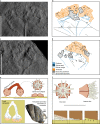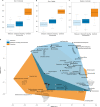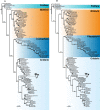A crown-group cnidarian from the Ediacaran of Charnwood Forest, UK - PubMed (original) (raw)
A crown-group cnidarian from the Ediacaran of Charnwood Forest, UK
F S Dunn et al. Nat Ecol Evol. 2022 Aug.
Abstract
Cnidarians are a disparate and ancient phylum, encompassing corals and jellyfish, and occupy both the pelagic and benthic realms. They have a rich fossil record from the Phanerozoic eon lending insight into the early history of the group but, although cnidarians diverged from other animals in the Precambrian period, their record from the Ediacaran period (635-542 million years ago) is controversial. Here, we describe a new fossil cnidarian-Auroralumina attenboroughii gen. et sp. nov.-from the Ediacaran of Charnwood Forest (557-562 million years ago) that shows two bifurcating polyps enclosed in a rigid, polyhedral, organic skeleton with evidence of simple, densely packed tentacles. Auroralumina displays a suite of characters allying it to early medusozoans but shows others more typical of Anthozoa. Phylogenetic analyses recover Auroralumina as a stem-group medusozoan and, therefore, the oldest crown-group cnidarian. Auroralumina demonstrates both the establishment of the crown group of an animal phylum and the fixation of its body plan tens of millions of years before the Cambrian diversification of animal life.
© 2022. The Author(s).
Conflict of interest statement
The authors declare no competing interests.
Figures
Fig. 1. Holotype specimen of Auroralumina attenboroughii.
a, In context alongside rangeomorph fossils preserved in a comparable manner and distinct from the textured background substrate (GSM 105874); imaged under low-angle light. b,c, Plastotype (GSM 106119) (b) and interpretative drawing (c) showing the differentiated stalk and cup of each goblet, well-defined corner sulci (now ridges) and texturally distinct tentacles. The proximal portions of both goblets, including their mutual branching point, are concealed beneath a thin cover of sediment but are nonetheless discernible as topographically and texturally distinct tracts (dashed grey line); see Fig. 2 for more information. RTI file available.
Fig. 2. Details of the proximal part of the holotype specimen of Auroralumina (GSM 106119).
a, Interpretative drawing of entire specimen, with area shown in b–d outlined. b, Base of the preserved specimen, showing progressive cover of the left-hand goblet towards the bifurcation point and the mostly concealed proximal part of the right-hand goblet. The margins of the fossil in the concealed area are impressed—albeit weakly—through the sediment and the area underlain by the skeleton is defined by a change in sediment texture. Fossil photographed under low-angle light. c, Interpretative overlay, generated by combining observations made under multiple lighting directions. d, Interpretative drawing from c, showing symmetrical bifurcation of the two goblets and probable broken proximal termination of the specimen. Key in d covers all annotations in this figure. Scale bar in b and c, 5 cm.
Fig. 3. Details of the distal anatomy of Auroralumina attenboroughii (GSM 106119) and the mode of preservation.
a, Left-hand goblet, with dense crown of overlapping tentacles and conspicuous corner sulcus (now a ridge) and band (now a trench) near the aperture rim. The margins of the fossil are well-defined and the tentacle crown texturally and topographically distinct from the smooth periderm. b, Interpretative drawing of region in a. c, Right-hand goblet, principally preserving only one face but with a second partially visible where its edge (and intervening corner sulcus) was twisted into the plane of preservation, towards the right-hand side. d, Interpretative drawing of region in c. Specimen photographed under low-angle light and interpretations based on features revealed by varying the lighting direction. Scale bar in a and c, 5 cm. e,f, Preservation of the goblet and tentacles of A. attenboroughii. e, Apical view of the two goblets showing how their different orientations at the time of burial generated different views of the tetraradial structure in the fossil in lateral aspect. Schematic goblets (labelled 1 and 2) are representative of the two goblets in Auroralumina. The interpretative drawing of Auroralumina is also shown, with goblets labelled 1 and 2 next to a conulariid cnidarian (OUMNH DU17), also inferred to have been tetraradial in life, to illustrate analogous preservation of multiple faces in lateral view. f, Hypothetical arrangement of the tentacles in oral view in vivo and probable arrangement of tentacles in lateral view at time of burial along with proposed preservational pathway of the tentacles. 1: Tentacles, mostly overlapping, buried by sediment. 2: Partial retraction and deflation postmortem. 3: Decay and casting of the resultant space by sediment from below.
Fig. 4. The Phylogenetic position of Auroralumina attenboroughii.
a, Artistic reconstruction of Auroralumina. b, Bayesian phylogenetic analysis of animals (348 characters, 108 taxa, mk + gamma model) incorporating Auroralumina attenboroughii. Numbers indicate posterior probabilities and scale bar shows expected number of substitutions per site. Fossils are indicated by dagger symbols. Raw polyp width is shown on the right, with the mean size shown for the extant groups sampled (for logged polyp size graph, see Extended Data Fig. 3). Branch length shown. Maximum polyp width data also shown in Extended Data Fig. 3. NA indicates where ancestral state values were inapplicable because they were derived from characters recovered as absent.
Fig. 5. Tubular morphospace occupation across the Ediacaran–Cambrian transition.
a–c, The sum of variances (a), sum of ranges (b) and the median of centroids (c) for tubular morphospace occupation. The sum of variances examines the evenness of morphospace occupation, the sum of ranges examines the extent of morphospace occupation in all computed dimensions and the median of centroids measures the clustering of taxa around a central point. Adding Auroralumina increases the sum of variances, ranges and (marginally) the median of centroids compared to Ediacaran morphospace excluding Auroralumina. The boxes represent the interquartile range, with black line showing the median. The whiskers indicate minimum (Q1 − 1.5 × IQR) and maximum (Q3 + 1.5 × IQR), excluding outliers. Outliers are shown in black squares. d, Morphospace occupation with convex hulls showing Ediacaran morphospace occupation with and without Auroralumina and Cambrian morphospace occupation. Black circles represent Ediacaran taxa and white circles represent Cambrian taxa.
Extended Data Fig. 1. Unconstrained phylogenetic topologies presented in full.
(a) Excluding the fossil taxa Namacalathus and Eolympia, Antipathes and those taxa that posses uninformative character states after safe taxonomic reduction (b) including all taxa. Auroralumina is recovered as a cnidarian in both trees. Fossil cnidarians are shown in bold and the position of Auroralumina is highlighted with a silhouette. Scale bar for branch lengths is in units of expected number of substitutions per site.
Extended Data Fig. 2. Constrained phylogenetic topologies.
(a) ‘Ctenosis’ (ctenophores as sister to all other animals) constrained. (b) Living cnidarian inter-relationships constrained against recent molecular phylogenies. All fossils were allowed to fully explore treespace under both set of constraints. Auroralumina is recovered as a cnidarian in both cases. Fossil cnidarians are shown in bold and the position of Auroralumina highted with with a silhouette. Scale bar for branch lengths is in units of expected number of substitutions per site.
Extended Data Fig. 3. Maximum polyp width in cnidarians.
Maximum polyp width plotted for extant cnidarian Classes and fossil groups. Auroralumina has a much larger polyp width than any other sampled medusozoan. Maximum conulariid polyp width is also larger than any sampled living medusozoan. Source data available with manuscript.
Comment in
- Lifting the veil on the oldest-known animals.
Laflamme M. Laflamme M. Nature. 2022 Sep;609(7929):904-905. doi: 10.1038/d41586-022-02893-4. Nature. 2022. PMID: 36100741 No abstract available.
Similar articles
- A macroscopic free-swimming medusa from the middle Cambrian Burgess Shale.
Moon J, Caron JB, Moysiuk J. Moon J, et al. Proc Biol Sci. 2023 Aug 9;290(2004):20222490. doi: 10.1098/rspb.2022.2490. Epub 2023 Aug 2. Proc Biol Sci. 2023. PMID: 37528711 Free PMC article. - Dawn of complex animal food webs: A new predatory anthozoan (Cnidaria) from Cambrian.
Ou Q, Shu D, Zhang Z, Han J, Van Iten H, Cheng M, Sun J, Yao X, Wang R, Mayer G. Ou Q, et al. Innovation (Camb). 2021 Dec 10;3(1):100195. doi: 10.1016/j.xinn.2021.100195. eCollection 2022 Jan 25. Innovation (Camb). 2021. PMID: 35005675 Free PMC article. - Cnidarian phylogenetic relationships as revealed by mitogenomics.
Kayal E, Roure B, Philippe H, Collins AG, Lavrov DV. Kayal E, et al. BMC Evol Biol. 2013 Jan 9;13:5. doi: 10.1186/1471-2148-13-5. BMC Evol Biol. 2013. PMID: 23302374 Free PMC article. - The origin of the animals and a 'Savannah' hypothesis for early bilaterian evolution.
Budd GE, Jensen S. Budd GE, et al. Biol Rev Camb Philos Soc. 2017 Feb;92(1):446-473. doi: 10.1111/brv.12239. Epub 2015 Nov 20. Biol Rev Camb Philos Soc. 2017. PMID: 26588818 Review. - The rise and early evolution of animals: where do we stand from a trace-fossil perspective?
Mángano MG, Buatois LA. Mángano MG, et al. Interface Focus. 2020 Aug 6;10(4):20190103. doi: 10.1098/rsfs.2019.0103. Epub 2020 Jun 12. Interface Focus. 2020. PMID: 32642049 Free PMC article. Review.
Cited by
- Protomelission is an early dasyclad alga and not a Cambrian bryozoan.
Yang J, Lan T, Zhang XG, Smith MR. Yang J, et al. Nature. 2023 Mar;615(7952):468-471. doi: 10.1038/s41586-023-05775-5. Epub 2023 Mar 8. Nature. 2023. PMID: 36890226 - Developmental biology of Spiralicellula and the Ediacaran origin of crown metazoans.
Sun W, Yin Z, Liu P, Zhu M, Donoghue P. Sun W, et al. Proc Biol Sci. 2024 May;291(2023):20240101. doi: 10.1098/rspb.2024.0101. Epub 2024 May 29. Proc Biol Sci. 2024. PMID: 38808442 Free PMC article. - Ediacaran origin and Ediacaran-Cambrian diversification of Metazoa.
Carlisle E, Yin Z, Pisani D, Donoghue PCJ. Carlisle E, et al. Sci Adv. 2024 Nov 15;10(46):eadp7161. doi: 10.1126/sciadv.adp7161. Epub 2024 Nov 13. Sci Adv. 2024. PMID: 39536100 Free PMC article. - 'Conga lines' of Ediacaran fronds: insights into the reproductive biology of early metazoans.
Delahooke KM, Liu AG, Stephenson NP, Mitchell EG. Delahooke KM, et al. R Soc Open Sci. 2024 May 29;11(5):231601. doi: 10.1098/rsos.231601. eCollection 2024 May. R Soc Open Sci. 2024. PMID: 39076788 Free PMC article. - Exceptional soft tissue preservation reveals a cnidarian affinity for a Cambrian phosphatic tubicolous enigma.
Zhang G, Parry LA, Vinther J, Ma X. Zhang G, et al. Proc Biol Sci. 2022 Nov 9;289(1986):20221623. doi: 10.1098/rspb.2022.1623. Epub 2022 Nov 2. Proc Biol Sci. 2022. PMID: 36321492 Free PMC article.
References
- Wilby PR, Carney JN, Howe MP. A rich Ediacaran assemblage from eastern Avalonia: evidence of early widespread diversity in the deep ocean. Geology. 2011;39:655–658. doi: 10.1130/G31890.1. - DOI
- Noble S, et al. Age and global context of the Ediacaran fossils of Charnwood Forest, Leicestershire, UK. Geol. Soc. Am. Bull. 2015;127:250–265. doi: 10.1130/B31013.1. - DOI
- Han J, et al. Olivooides-like tube aperture in early Cambrian carinachitids (Medusozoa, Cnidaria) J. Paleontol. 2018;92:3–13. doi: 10.1017/jpa.2017.10. - DOI
- De Moraes Leme J, Guimarães Simões M, Carlos Marques A, Van Iten H. Cladistic analysis of the suborder Conulariina Miller and Gurley, 1896 (Cnidaria, Scyphozoa; Vendian–Triassic) Palaeontology. 2008;51:649–662. doi: 10.1111/j.1475-4983.2008.00775.x. - DOI
- Morris SC, Menge C. Carinachitids, hexangulaconulariids, and Punctatus: problematic metazoans from the Early Cambrian of South China. J. Paleontol. 1992;66:384–406. doi: 10.1017/S0022336000033953. - DOI
Publication types
MeSH terms
LinkOut - more resources
Full Text Sources







